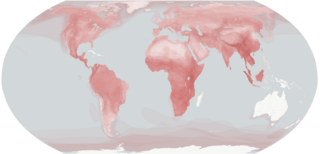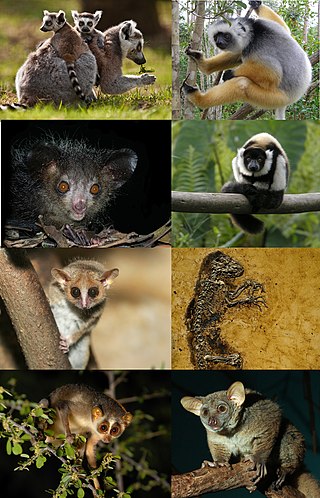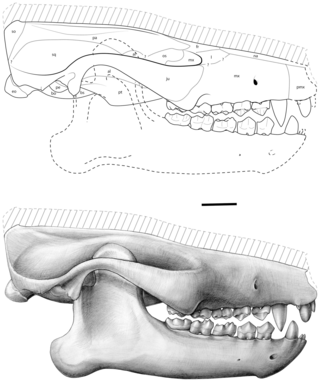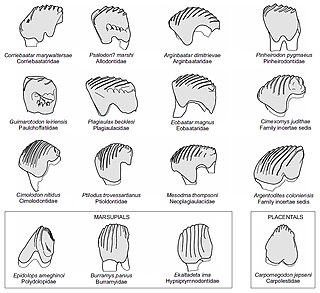Related Research Articles

Carnivora is an order of placental mammals that have specialized in primarily eating flesh, whose members are formally referred to as carnivorans. The order Carnivora is the fifth largest order of mammals, comprising at least 279 species.

In amniotes, the clitoris is a female sex organ. In humans, it is the vulva's most erogenous area and generally the primary anatomical source of female sexual pleasure. The clitoris is a complex structure, and its size and sensitivity can vary. The visible portion, the glans, of the clitoris is roughly the size and shape of a pea and is estimated to have at least 8,000 sensory nerve endings.

The labia minora, also known as the inner labia, inner lips, or nymphae, are two flaps of skin that are part of the primate vulva, extending outwards from the vaginal and urethral openings to encompass the vestibule. The labia minora are situated between the labia majora and together form the labia. They vary widely in size, color and shape from individual to individual.

A mammal is a vertebrate animal of the class Mammalia. Mammals are characterized by the presence of milk-producing mammary glands for feeding their young, a neocortex region of the brain, fur or hair, and three middle ear bones. These characteristics distinguish them from reptiles and birds, from which their ancestors diverged in the Carboniferous Period over 300 million years ago. Around 6,400 extant species of mammals have been described and divided into 29 orders.

The walrus is a large pinniped marine mammal with discontinuous distribution about the North Pole in the Arctic Ocean and subarctic seas of the Northern Hemisphere. It is the only extant species in the family Odobenidae and genus Odobenus. This species is subdivided into two subspecies: the Atlantic walrus, which lives in the Atlantic Ocean, and the Pacific walrus, which lives in the Pacific Ocean.
The glans is a vascular structure located at the tip of the penis in male mammals or a homologous genital structure of the clitoris in female mammals.

Strepsirrhini or Strepsirhini is a suborder of primates that includes the lemuriform primates, which consist of the lemurs of Madagascar, galagos ("bushbabies") and pottos from Africa, and the lorises from India and southeast Asia. Collectively they are referred to as strepsirrhines. Also belonging to the suborder are the extinct adapiform primates which thrived during the Eocene in Europe, North America, and Asia, but disappeared from most of the Northern Hemisphere as the climate cooled. Adapiforms are sometimes referred to as being "lemur-like", although the diversity of both lemurs and adapiforms does not support this comparison.

Spider monkeys are New World monkeys belonging to the genus Ateles, part of the subfamily Atelinae, family Atelidae. Like other atelines, they are found in tropical forests of Central and South America, from southern Mexico to Brazil. The genus consists of seven species, all of which are under threat; the brown spider monkey is critically endangered. They are also notable for their ability to be easily bred in captivity.

The baculum, also known as the penis bone, penile bone, os penis, os genitale, or os priapi, is a bone in the penis of many placental mammals. It is absent from the human penis, but present in the penises of some primates, such as the gorilla and the chimpanzee. The baculum arises from primordial cells in soft tissues of the penis, and its formation is largely influenced by androgens. The bone lies above the urethra, and it aids sexual reproduction by maintaining stiffness during sexual penetration. The homologue to the baculum in female mammals is the baubellum, a bone in the clitoris.
Encephalization quotient (EQ), encephalization level (EL), or just encephalization is a relative brain size measure that is defined as the ratio between observed and predicted brain mass for an animal of a given size, based on nonlinear regression on a range of reference species. It has been used as a proxy for intelligence and thus as a possible way of comparing the intelligence levels of different species. For this purpose, it is a more refined measurement than the raw brain-to-body mass ratio, as it takes into account allometric effects. Expressed as a formula, the relationship has been developed for mammals and may not yield relevant results when applied outside this group.

Clitoromegaly is an abnormal enlargement of the clitoris that is mostly congenital; it is otherwise acquired through deliberately induced clitoral enlargement e.g. body modification by use of anabolic steroids, including testosterone. It is not the same as normal enlargement of the clitoris seen during sexual arousal.

The long-tailed vole, in some areas known as the San Bernardino long-tailed vole, is a small vole found in western North America. They have short ears and a long tail. Their fur is gray brown with light gray underparts. They are around 18 cm (7.1 in) long with an 8 cm (3.1 in) tail and weigh about 50 g (1.8 oz).
A pseudo-penis is any structure found on an animal that, while superficially appearing to be a penis, is derived from a different developmental path.

Many mammalian species have developed keratinized penile spines along the glans and/or shaft, which may be involved in sexual selection. These spines have been described as being simple, single-pointed structures (macaques) or complex with two or three points per spine (strepsirrhines). Penile spine morphology may be related to mating system.

Sexual selection in mammals is a process the study of which started with Charles Darwin's observations concerning sexual selection, including sexual selection in humans, and in other mammals, consisting of male–male competition and mate choice that mold the development of future phenotypes in a population for a given species.

Ocepeia is an extinct genus of afrotherian mammal that lived in present-day Morocco during the middle Paleocene epoch, approximately 60 million years ago. First named and described in 2001, the type species is O. daouiensis from the Selandian stage of Morocco's Ouled Abdoun Basin. A second, larger species, O. grandis, is known from the Thanetian, a slightly younger stage in the same area. In life, the two species are estimated to have weighed about 3.5 kg (7.7 lb) and 10 kg (22 lb), respectively, and are believed to have been specialized leaf-eaters. The fossil skulls of Ocepeia are the oldest known afrotherian skulls, and the best-known of any Paleocene mammal in Africa.

The evolutionary history of the primates can be traced back 57-90 million years. One of the oldest known primate-like mammal species, Plesiadapis, came from North America; another, Archicebus, came from China. Other similar basal primates were widespread in Eurasia and Africa during the tropical conditions of the Paleocene and Eocene. Purgatorius is the genus of the four extinct species believed to be the earliest example of a primate or a proto-primate, a primatomorph precursor to the Plesiadapiformes, dating to as old as 66 million years ago.

Sperm competition is a form of post-copulatory sexual selection whereby male sperm simultaneously physically compete to fertilize a single ovum. Sperm competition occurs between sperm from two or more rival males when they make an attempt to fertilize a female within a sufficiently short period of time. This results primarily as a consequence of polyandrous mating systems, or due to extra-pair copulations of females, which increases the chance of cuckoldry, in which the male mate raises a child that is not genetically related to him. Sperm competition among males has resulted in numerous physiological and psychological adaptations, including the relative size of testes, the size of the sperm midpiece, prudent sperm allocation, and behaviors relating to sexual coercion, however this is not without consequences: the production of large amounts of sperm is costly and therefore, researchers have predicted that males will produce larger amounts of semen when there is a perceived or known increase in sperm competition risk.

A plagiaulacoid is a type of blade-like, most often serrated, tooth present in various mammal groups, usually a premolar. Among modern species it is present chiefly on diprotodontian marsupials, which have both the upper and lower first premolars converted into serrated blades. However, various other extinct groups also possessed plagiaulacoids. These would be multituberculates, some "Plesiadapiformes" such as Carpolestes and various metatherians such as Epidolops and various early diprotodontians. In many of these only a lower premolar became converted into a blade, while the upper premolars showed less specialisation.
The clitoris is a female sex organ present in mammals, ostriches and other amniotes.
References
- ↑ "A Long-Lost Bone". National Geographic Society . 3 September 2013. Archived from the original on March 3, 2021.
- ↑ Martin, Robert D. (2007). "The evolution of human reproduction: A primatological perspective". American Journal of Physical Anthropology. 134: 59–84. doi: 10.1002/ajpa.20734 . PMID 18046752. S2CID 44416632.
- ↑ Friderun Ankel-Simons (27 July 2010). Primate Anatomy: An Introduction. Elsevier. ISBN 978-0-08-046911-9.
- 1 2 Lough-Stevens, Michael; et al. (January 2018). "The baubellum is more developmentally and evolutionarily labile than the baculum". Ecology and Evolution. 8 (2): 1073–1083. doi: 10.1002/ece3.3634 . PMC 5773289 . PMID 29375780.
- ↑ Sloan, Nadia (September 2019). "The evolution of female genitalia". Journal of Evolutionary Biology. 32 (9): 882–899. doi: 10.1111/jeb.13503 . PMID 31267594.
- ↑ Claude Perrault (1748). Mémoires pour servir à l'histoire naturelle des animaux (in French). Arkstee & Merkus.
- ↑ Zoologische Bruchstücke , p. 41, at Google Books
- ↑ Shortridge, G. C. (1934). The mammals of South West Africa. William Heinemann Ltd.
- ↑ James N. Layne (August 1954). "The os clitoridis of some North American Sciuridae". Journal of Mammalogy. 35 (3): 357–366. doi:10.2307/1375960. JSTOR 1375960 . Retrieved September 21, 2022.
- ↑ James N. Layne (1952). "The os genitale of the red quirrel, Tamiasciurus". Journal of Mammalogy. 33 (4): 457–459. doi:10.2307/1376017. JSTOR 1376017 . Retrieved 21 September 2022.
- ↑ Kutzler M.; Keller G.G.; Smith F. (2020-01-11). Os clitoridis incidence on radiographs submitted for coxofemoral dysplasia evaluations. International Symposium on Canine and Feline Reproduction | IVIS. www.ivis.org. Retrieved 2022-09-21.
- ↑ "Aplodontia rufa" (PDF). Mammalian Species. 431: 1–10. April 23, 1993.
- 1 2 H. Burrows (2013). Biological Actions of Sex Hormones. Cambridge University Press. p. 226. ISBN 978-1-107-62550-1.
- 1 2 Leonard Janet; Alex Cordoba-Aguilar (2010). The Evolution of Primary Sexual Characters in Animals. Cambridge University Press. ISBN 978-0-19-971703-3.
- 1 2 WH (1960). Bacula of North American Mammals. Museum of Zoology, University of Michigan. hdl:2027.42/56357.
- ↑ Pascal Picq; Philippe Brenot (2009). Odile Jacob (ed.). Le Sexe, l'Homme et l'Évolution (in French). Odile Jacob. ISBN 9782738195661.
- ↑ Bones and Cartilage: Developmental and Evolutionary Skeletal Biology , p. 344, at Google Books